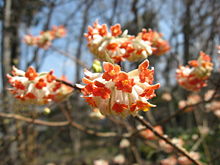
The Polygonaceae are a family of flowering plants known informally as the knotweed family or smartweed—buckwheat family in the United States. The name is based on the genus Polygonum, and was first used by Antoine Laurent de Jussieu in 1789 in his book, Genera Plantarum. The name may refer to the many swollen nodes the stems of some species have, being derived from Greek [poly meaning 'many' and gony meaning 'knee' or 'joint']. Alternatively, it may have a different origin, meaning 'many seeds'.

The Canellaceae are a family of flowering plants in the order Canellales. The order includes only one other family, the Winteraceae. Canellaceae is native to the Afrotropical and Neotropical realms. They are small to medium trees, rarely shrubs, evergreen and aromatic. The flowers and fruit are often red.

Picris (oxtongues) is a genus of flowering plants in the family Asteraceae described as a genus by Linnaeus in 1753.
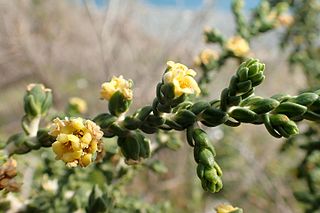
The Thymelaeaceae are a cosmopolitan family of flowering plants composed of 50 genera and 898 species. It was established in 1789 by Antoine Laurent de Jussieu. The Thymelaeaceae are mostly trees and shrubs, with a few vines and herbaceous plants.

Eriophorum is a genus of flowering plants in the family Cyperaceae, the sedge family. They are found in the cool temperate, alpine, and Arctic regions of the Northern Hemisphere, primarily in the middle latitudes of North America, Europe, and Asia.

Cardiocrinum is a genus of bulbous plants of the lily family first described in 1846. They are native to the Himalaya, China, the Russian Far East, and Japan. The bulbs are usually formed at the soil surface. The preferred habitat is woodland. The plants tend to be monocarpic, dying after flowering.

Theophrastoideae is a small subfamily of flowering plants in the family Primulaceae. It was formerly recognized as a separate family Theophrastaceae. As previously circumscribed, the family consisted of eight genera and 95 species of trees or shrubs, native to tropical regions of the Americas.

Picramnia, the bitterbushes, is a genus of flowering plants generally placed in the family Picramniaceae, but sometimes included in Simaroubaceae. The name is conserved against the genera Pseudo-brasiliumAdans., and TaririAubl., both which have been rejected.

Halodule is a genus of plants in the family Cymodoceaceae described as a genus in 1841. It is widespread on tropical and semi-tropical ocean shores of all continents except Europe and Antarctica.

Rosularia is a small genus of the family Crassulaceae. It includes about 28-35 species from Europe, the Himalayas, and northern Africa.

Subularia is a genus of plants in the family Brassicaceae. Subularia species are annual herbs that grow in moist or even flooded soils. There are only two species of the genus: Subularia aquatica, which is widespread in North America and Europe; and Subularia monticola, from Africa mountains. Awlwort is a common name for plants in this genus.
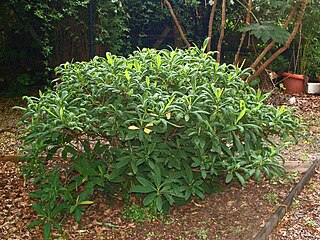
Edgeworthia chrysantha is a plant in the family Thymelaeaceae.
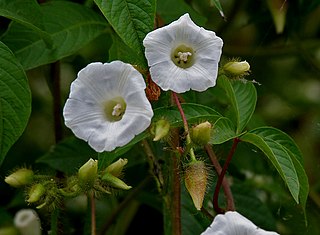
Merremia is a genus of flowering plants in the morning glory family, Convolvulaceae. Members of the genus are commonly known as woodroses.

Edgeworthia gardneri is a plant in the Thymelaeaceae family. It is a small evergreen shrub growing up to 3–4 metres (10–13 ft) tall. It can be distinguished by its brownish red stem. The flowers are hermaphrodite.

Cytinus hypocistis is an ant-pollinated species of parasitic plant in the family Cytinaceae having four subspecies. It is found primarily in locations that surround the Mediterranean Sea, and is the type for the genus Cytinus. The binomial has been conserved.

Schiekia is a genus of herbs in the family Haemodoraceae, first described as a genus in 1957. It contains only one recognized species, Schiekia orinocensis, native to South America. This plant grasped the minds of many scientists who tried fruitlessly to discover its purpose in the natural order.

Ceropegia candelabrum is the type species in its genus of plants, belonging the subfamily Asclepiadoideae. The Latin specific epithet candelabrum is derived from the candelabra-like appearance of the inflorescences.
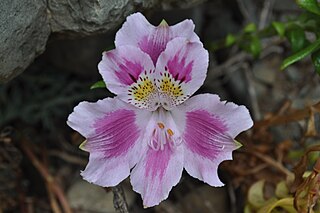
Alstroemeria pelegrina, the Peruvian lily, is a species of flowering plant in the large genus Alstroemeria of the family Alstroemeriaceae (Inca-lilies), part of the monocot order Liliales. It is the type-species of that genus, originally described by Linnaeus in 1762 as one of three species of Alstroemeria. It is a herbaceous rhizomatous perennial endemic to Chile.

The Tradescantieae are a tribe of plants in the family Commelinaceae erected by Carl Meissner in 1842. Many genera originate from the Americas, but those in subtribes Coleotrypinae, Cyanotinae, Palisotinae and Streptoliriinae are Asian or African in origin; several species in the typical Tradescantia and other genera have become domesticated ornamental plants and naturalised elsewhere.
